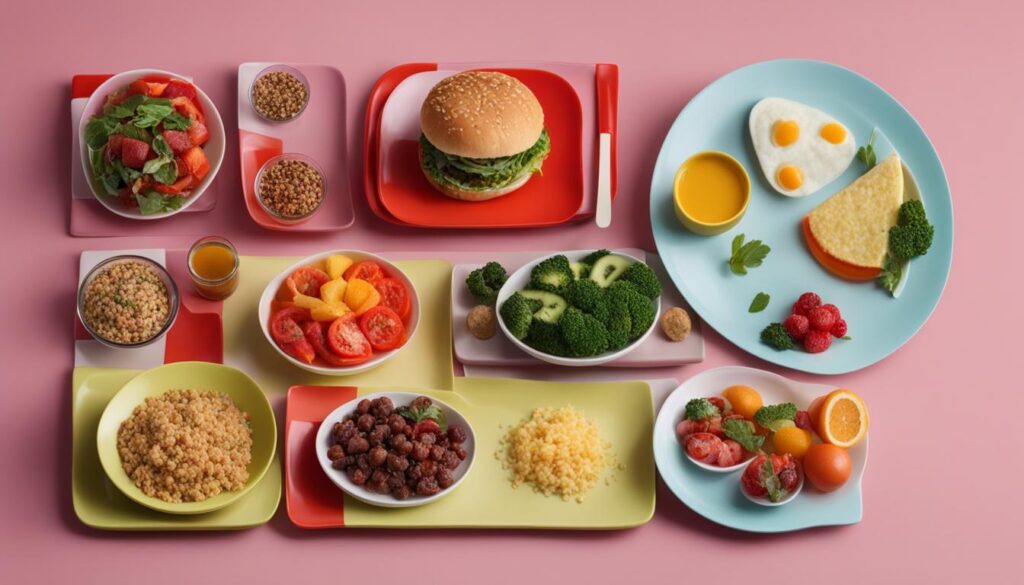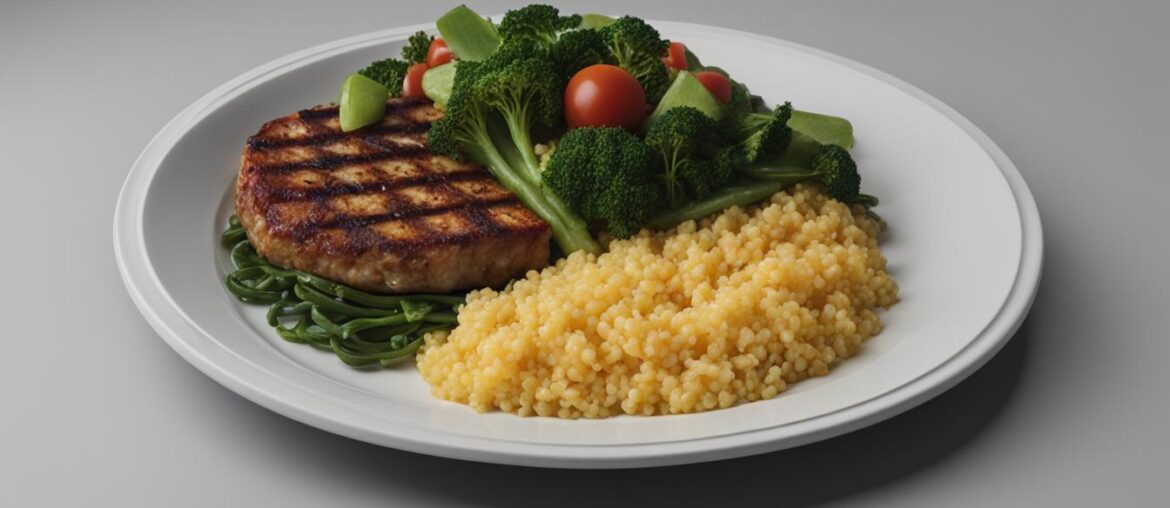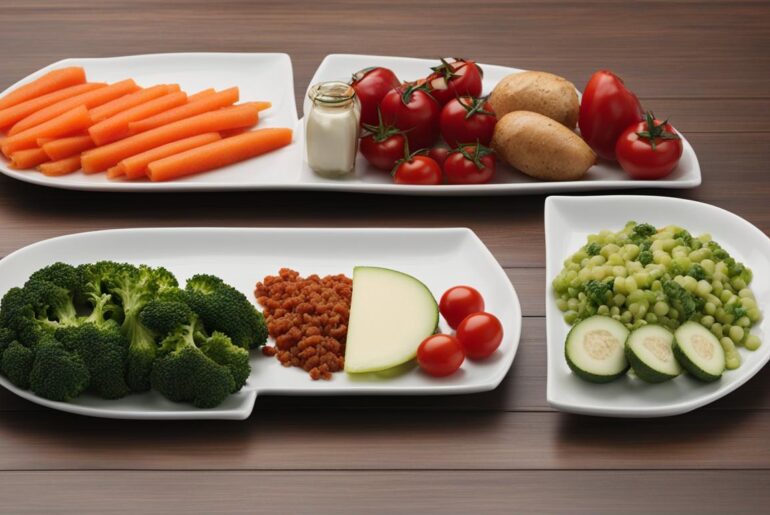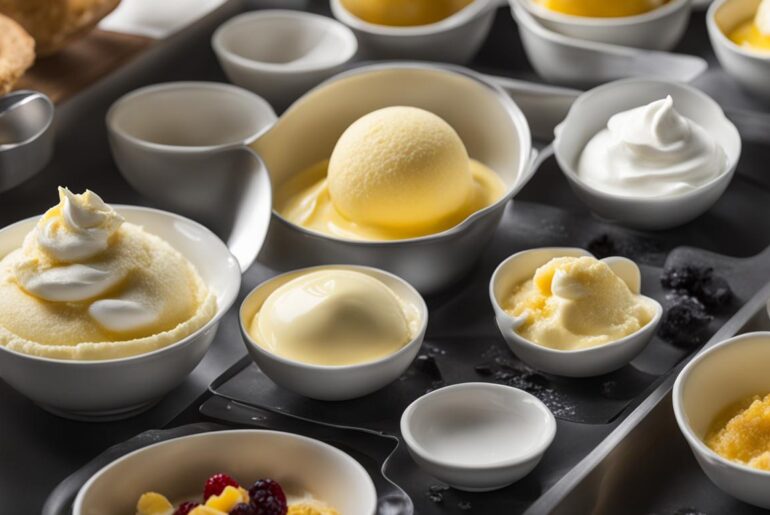When it comes to managing portion sizes for a healthier lifestyle, one effective strategy is to consider the ideal plate size for portion control (check this post out). The size of your plate can play a significant role in preventing overeating and promoting portion control.
Using a smaller plate can trick your mind into perceiving larger portions and make standard-sized servings appear more satisfying. By visually filling a smaller plate, you can avoid the temptation to overload it with excessive amounts of food.
Another helpful tip is to eliminate unnecessary starchy carbohydrates from your plate, such as doubling up on bread or pasta. Instead, focus on nutrient-dense options like fruits, vegetables, and lean proteins.
Measuring cups can also be a useful tool to gauge the right amount of food. By being aware of portion sizes, you can ensure that you are not unknowingly consuming more than necessary.
Additionally, it’s important to be selective with your seconds. Instead of automatically going for another helping, give yourself some time to assess if you are truly hungry or simply eating out of habit or boredom. Opt for healthier choices like a serving of fruit if you still feel the need for more.
Waiting at least 20 minutes before considering a second helping is also beneficial. This allows your body time to register feelings of fullness and can prevent overeating.
If you’re unsure about portion sizes, checking food labels can provide valuable information. Understanding the recommended serving sizes listed on packages can guide you in making informed choices.
When dining out, be conscious of the tendency for larger portion sizes to be served in restaurants. Don’t hesitate to ask for a half portion or choose from the children’s menu. Sharing a meal with a friend or family member or ordering a starter and a side dish instead of a main course can also help control portion sizes.
By taking into account the energy density, or the amount of energy in a given weight of food, you can better determine appropriate portion sizes. An awareness of portion control strategies and the ideal plate size can contribute to a healthier and more balanced approach to eating (check this post out).
Key Takeaways:
- Using a smaller plate can trick your mind into perceiving larger portions.
- Eliminate unnecessary starchy carbohydrates from your plate.
- Measuring cups can help gauge the right amount of food.
- Be selective with your seconds and opt for healthier choices like fruit.
- Wait 20 minutes before considering a second helping to allow time for fullness cues.
The Influence of Plate Size on Portion Control
Research suggests that the size of plates, spoons, and glasses can unconsciously influence how much food someone eats. Using smaller dinnerware can make food appear larger and lead to reduced portion sizes. Dividing a plate into sections based on different food groups can help guide portion control. The optimal macronutrient ratio for a well-balanced meal is half the plate for vegetables or salad, a quarter of the plate for high-quality protein, a quarter of the plate for complex carbs, and a small amount of high-fat foods. Using hands as a serving guide can also help determine appropriate portion sizes.
The Influence of Plate Size
Research suggests that the size of plates, spoons, and glasses can unconsciously influence how much food someone eats.
Plate size plays a significant role in portion control. When using a smaller plate, the same amount of food appears larger, which can trick the brain into feeling satisfied with smaller portions. By reducing plate size, individuals can effectively manage their portion sizes and avoid overeating.
Dividing the Plate
One effective strategy for portion control is to divide the plate into sections based on different food groups. This method not only helps control portion sizes but also ensures a well-balanced meal. The recommended macronutrient ratio is to dedicate half of the plate to vegetables or salad, a quarter to high-quality protein, a quarter to complex carbs, and a small amount to high-fat foods.
Serving Guide with Hands
Another helpful approach to determine appropriate portion sizes is by using hands as a serving guide. Each hand represents a different food group:
- A palm-sized amount of protein (meat, poultry, fish)
- A fist-sized portion of complex carbohydrates (rice, pasta, bread)
- A cupped hand-sized portion of vegetables or salad
- A thumb-sized amount of high-fat foods (oils, butter, nuts)
By utilizing these serving guides, individuals can easily estimate appropriate portion sizes without the need for measuring cups or scales.
Image
| Regular Plate Size | Smaller Plate Size |
|---|---|
| A larger plate makes a standard portion look smaller, leading to overeating. | A smaller plate makes a standard portion look larger, reducing the risk of overeating. |
| A larger plate can encourage larger portion sizes, contributing to weight gain. | A smaller plate promotes smaller portion sizes, aiding in weight management. |
| A larger plate can lead to a higher energy intake and calorie consumption. | A smaller plate can result in decreased energy intake and calorie consumption. |
Practical Tips for Portion Control

When it comes to portion control, plate size plays a crucial role in determining the amount of food we consume. Choosing the right plate size can help us maintain a balanced diet and manage our calorie intake effectively. Here are some practical tips to help you control your portions:
- Eating out: Restaurants often serve larger portion sizes, making it challenging to control how much we eat. When dining out, consider asking for a half portion or a children’s dish, as these are usually smaller and more appropriate for portion control. Alternatively, you can share a meal with a friend or opt for a starter and side dish instead of a main course.
- Starting with water: Before diving into your meal, start with a glass of water. Not only does this help quench thirst, but it also helps reduce calorie intake by distinguishing between hunger and thirst. By hydrating before your meal, you can make more informed choices about portion sizes.
- Eating mindfully: Slow down and savor each bite. Eating slowly without distractions allows your body to register feelings of fullness, preventing overeating. Put away electronic devices and focus on the flavors, textures, and satisfaction you get from your food.
- Avoiding container eating: Eating straight from a container or large packages can lead to mindless overeating. Instead, transfer a reasonable portion onto a plate or bowl. This allows you to visually gauge your portion size and prevents excessive consumption.
- Measuring and recording: Using measuring equipment such as measuring cups and food scales helps you accurately portion your meals. This allows you to be mindful of serving sizes and adjust accordingly. Additionally, reading food labels and keeping a food diary can increase your awareness of portion sizes and provide valuable insights into your overall food intake.
Remember, portion control is essential for maintaining a healthy weight and overall well-being. Implementing these practical tips can help you make informed choices about the food you consume and support your portion control efforts.
The Link Between Portion Size and Weight Gain
Increased portion sizes are thought to contribute to overeating and weight gain. Many factors can influence how much food people eat, including the size of the serving dishes. Portion control plates can help reduce self-selected portion sizes and promote weight loss.
Research has shown that serving food on smaller plates can make it appear larger and lead to the consumption of smaller portions.
Portion control plates with grooves indicating different portion sizes can further enhance portion control.
| Portion Control Plates | Benefits |
|---|---|
| 1. Divided into sections | Helps guide portion control and promotes balanced meals. |
| 2. Grooves indicating portion sizes | Visual cues provide a reference for portion control. |
| 3. Encourages mindful eating | Promotes awareness of portion sizes and prevents overeating. |
By using portion control plates, individuals can effectively manage their portion sizes and support their weight loss goals (check out my post on portion control plates here).
Conclusion
Portion control plates provide a practical and effective strategy for managing portion sizes and promoting weight loss. By using smaller plates, dividing them into sections based on food groups, and following serving guides, individuals can successfully control their portions and prevent overeating.
Being mindful of plate size is crucial in developing healthier eating habits and achieving better health outcomes. Portion control plates offer a visual cue to guide individuals in consuming appropriate portion sizes, ensuring balanced nutrition.
Incorporating portion control strategies and utilizing portion control plates can lead to significant improvements in overall health and well-being. It is recommended to make portion control plates a part of daily meal planning, ensuring that meals are satisfying and nutritionally balanced.
For those looking to take control of their portion sizes and improve their eating habits, portion control plates are a highly effective tool. With their help, individuals can better manage their food intake, foster healthier eating patterns, and ultimately achieve their weight loss goals.




